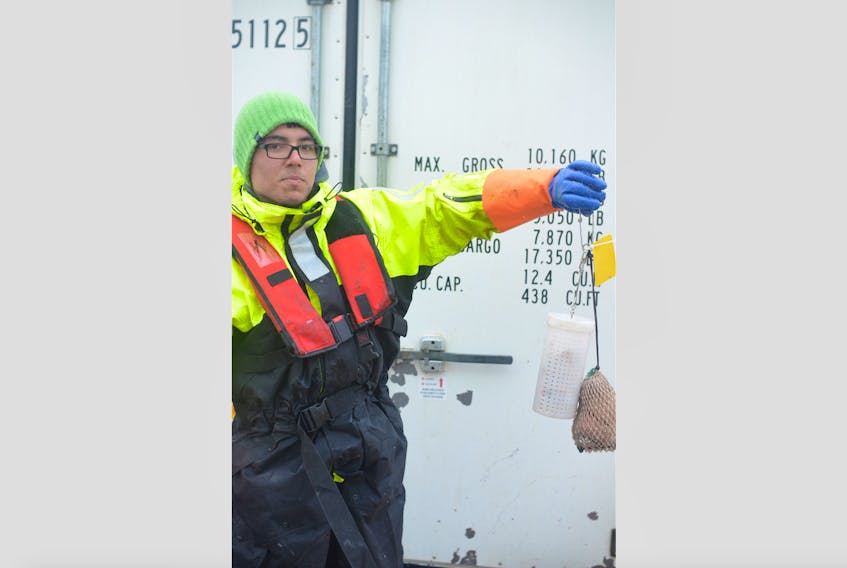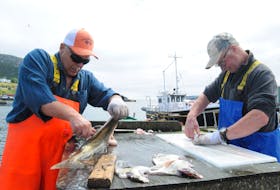A new study from Memorial University has found that seal bait can be used to catch snow crab.
The study, first conducted as a student thesis by Tomas Araya-Schmidt at Memorial University in 2017, found that seal fat, used as bait for crab, returned catch rates comparable to squid, the traditional bait used by snow crab harvesters.
It was conducted with Norwegian partnership in the Barents Sea, north of Norway.
The study was published in PeerJ, a peer-reviewed scientific journal, on May 13.
Five different types of bait were compared in the study, using harp seal and minke whale: seal fat, seal fat with skin, seal meat with bone, whale fat with skin and whale meat with fat.
But it was only seal fat and seal fat with skin that produced catch rates similar to squid.
While traps with squid returned 9.87 crabs per pot, while seat fat returned 13.8 crabs and seal fat with skin returned 13 crabs.
There was no difference in the size of the crab.
The researchers suggest it could, potentially, mean another market for seal products, which could benefit both seal hunters and crab harvesters in Newfoundland and Labrador.
Currently, seal is not being used as bait for snow crab in either Newfoundland and Labrador nor Norway.
Squid is the most frequently used bait for snow crab harvesters.
However, most of it is shipped from South America, whereas the market for Newfoundland and Labrador seal bait would be entirely local.
The study also found seal fat (without skin) was 57 per cent cheaper than squid (seal fat with skin was found to range anywhere between 35 per cent cheaper and eight per cent more expensive).
“It’s a local product, it doesn’t have a carbon footprint, it’s cheaper and you don’t have to refrigerate it all year round because these seal products are actually brined,” Dr. Paul Winger, a Memorial University professor who co-authored the study, told The Northern Pen.
More squid bait is also required to catch a given number of crabs.
Winger suggests a new bait market for harp seals could lead to more hunted in the province, or it could mean more of each seal would be utilized, with the fat now being used.
But there are obstacles.
Winger recognizes the seal hunt is a controversial subject for many, with strong opposition from a number of animal rights advocates and environmental groups.
“We understand the topic is a bit volatile,” he said. “The whole issue around the seal hunt, and whether we should be harvesting marine mammals. That’s a bit of a sensitive issue.”
Many countries do not accept seal products and it remains an open question whether they would import snow crab caught using seal.
“Maybe some of our markets wouldn’t want this kind of snow crab,” said Winger.
He cites the United States as one potential example.
Winger also wants to see more research.
He hopes they can conduct a similar study in Newfoundland and Labrador, to see whether seal baits return the same catch rates.
“I think it yielded interesting results and we’d love to see a study here,” he said. “Could those results be transferrable here? The answer is, we don’t know. And that would be the next starting point: to see if we can catch snow crab here, using seal.”
Crab fisherman responds
Roy Ward, a crab fisherman from Goose Cove on the Northern Peninsula, learned about the findings speaking with The Northern Pen.
He was not surprised, as he believes the strong odour would attract crab.
“Seal fat has a really strong odour, so I can’t see why it wouldn’t work,” he said.
Ward says crab harvesters sometimes experiment with different baits, but seal hasn’t been tested much because you need somewhere to store it through the winter.
“And no one got their freezers full of seals right now,” he added.
Ward also expressed some concern over whether the seal fat would change the taste of the crab.
He says when fishermen have tried different baits for whelks, for instance, it has changed the whelk’s flavour.
He doesn’t know if the same would happen with snow crab.
Nevertheless, Ward was intrigued by the findings, particularly the potential savings of using seal fat instead of squid.
“If we can cut down the price of bait, it’s the same as increasing the price of your product,” he said.
The study was authored by Tomas Araya-Schmidt, Paul Winger, Leonore Olsen, Lasse Rindahl and Roger Larsen.
It can be viewed here: https://peerj.com/articles/6874/
Per the Department of Fisheries and Oceans, 32,090 harp seal were landed in Atlantic Canada and Quebec, between January 1 and May 12, 2019.
This was the lowest number landed in the last 10 years.









